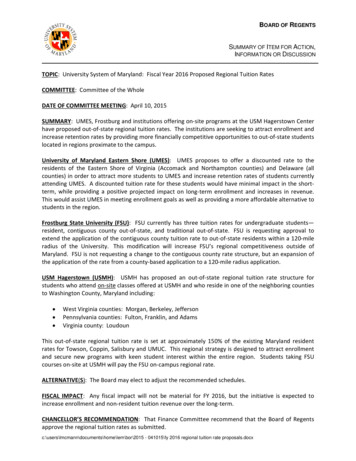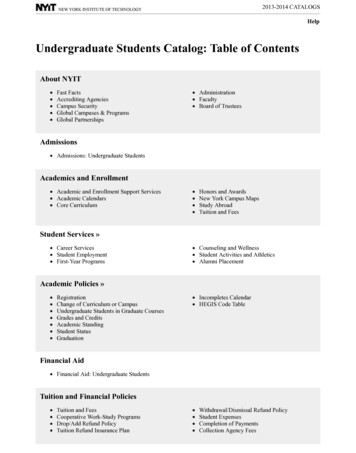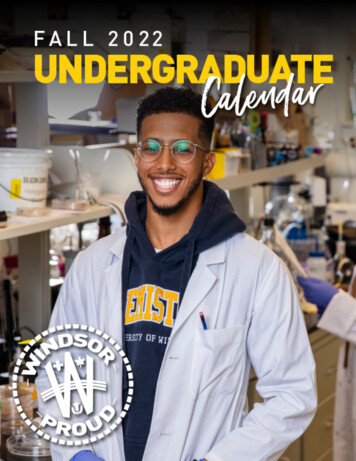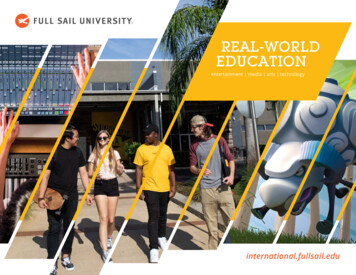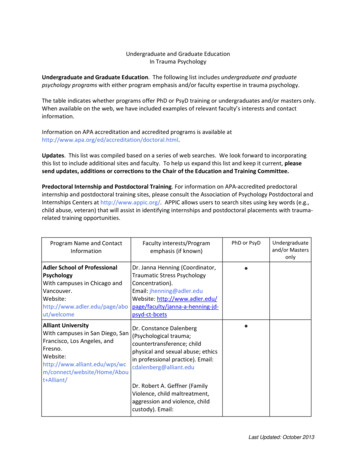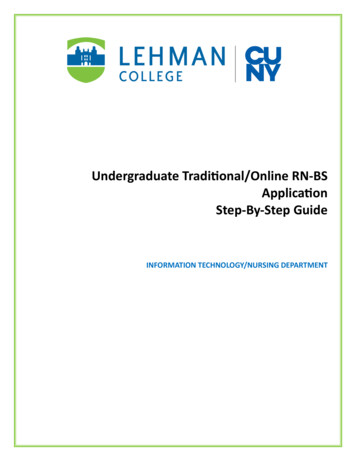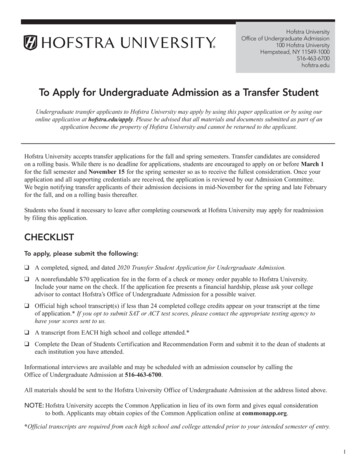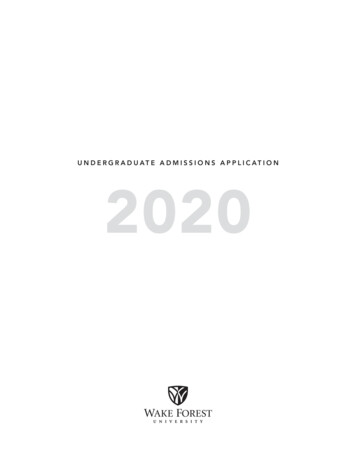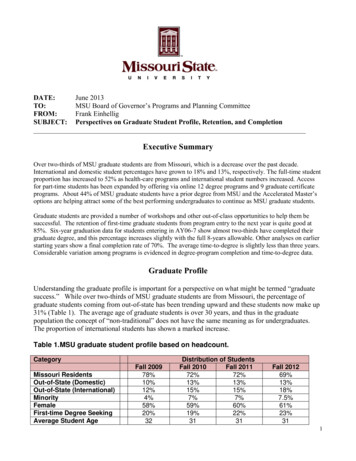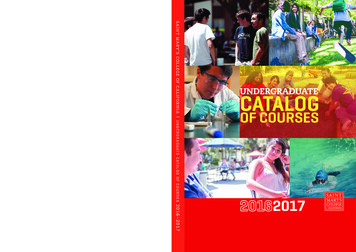
Transcription
CATALOGOF COURSES2017SA I N T M A RY’S COL L EGE OF C A L IFOR N I A U N D E R G R A D U AT E C ATA L O G O F C O U R S E S 2 0 16 – 2 0 1 7UNDERGRADUATE
3DIRECTIONS TO CAMPUS3ACADEMIC CALENDAR13School of Liberal Arts4THE COLLEGE15School of Science9COLLEGE POLICIES AND15School of Economics and Business13THE SCHOOLSDISCLOSURE SUMMARIES11AdministrationSIGNATURE PROGRAMS16Kalmanovitz School of Education11The Core Curriculum18ENROLLMENT AND ADMISSION12Collegiate Seminar22TUITION AND FEES12January Term25FINANCIAL AID29ACADEMIC OFFICERS AND SERVICES35STUDENT LIFE42ACADEMIC REQUIREMENTS52PROGRAM OF STUDY1
Contents572CURRICULUM143Integral Program58Accounting145Interfaith Leadership61Allied Health Science147January Term62Anthropology150Justice, Community and Leadership67Art and Art History154Kinesiology76Biochemistry159Mathematics and Computer Science77Biology164Performing Arts: Dance, Music and Theatre84Business Administration175Philosophy92Chemistry178Physics and Astronomy95Classical Languages181Politics98Collegiate Seminar189Pre-Professional Curricula102Communication191Psychology106Computer Science196Sociology106Cross-Cultural Studies200Studies and Curricular Requirements107Economics112Education201Theology & Religious Studies1163 2 Engineering210Women’s and Gender Studies116English and MFA in Creative Writing215World Languages and Cultures125Environmental and Earth Science Programs227COLLEGE ADMINISTRATION130Ethnic Studies231COLLEGE GOVERNMENT133Global and Regional Studies234UNDERGRADUATE FACULTY136History246CAMPUS MAP247INDEXfor International Students
Campus/CalendarTHE CAMPUSThe Saint Mary’s College campus is located in the rollinghills of the Moraga Valley. The 420-acre campus offersspaciousness and beauty with proximity to the culturalcenters of the San Francisco Bay Area.INFORMATIONFor more information about Saint Mary’s College programs,services and activities call the campus operator who willdirect you to the appropriate office: (925) 631-4000.DIRECTIONS TO CAMPUSFrom San Francisco Bay Bridge orSan Rafael / Richmond Bridge:Take Highway 580 toward Hayward and then Highway 24toward Walnut Creek. Once through the Caldecott Tunnel,take the second exit, which will be marked Orinda / Moraga.Turn right and follow Moraga Way about five miles. Turnleft onto Moraga Road, then right onto Saint Mary’s Road.The College is about one mile further on the right.From Walnut Creek / Highway 680:Take Highway 24 west (Oakland direction) to the CentralLafayette exit. Go right under freeway, right onto Mt.Diablo Blvd. one block, left onto Moraga Road 1/3 mile,and left onto Saint Mary’s Road about four miles. TheCollege will be on the left.From BART (Bay Area Rapid Transit):Take the SFO / Millbrae – Pittsburg / Bay Point train toeither the Orinda or the Lafayette station. From there,take the County Connection bus (Route 106) to SaintMary’s College. County Connection buses operate toand from the College from approximately 6 a.m. until6 p.m., Monday through Saturday. Buses also run from9:30 p.m. to 1:25 a.m. on Thursday and Friday, from 6:30p.m. to 1:25 a.m. on Saturday, and from noon to 1:25 a.m.on Sunday. For exact times of bus schedules or moreinformation, phone County Connection at (925) 676-7500.UNDERGRADUATEACADEMIC CALENDARFALL TERM 2016August 29 mondayFall Term CLASSES BEGINSeptember 5 mondayLabor Day HolidayOctober 20 – 21Midterm HolidayNovember 23 – 27Thanksgiving RecessDecember 5 – 8Final ExamsDecember 9 –January 8Christmas andNew Year’s RecessJANUARY AND SPRING TERMS 2017January 9 mondayJanuary TermCLASSES BEGINJanuary 16 mondayMartin Luther King, Jr.HolidayFebruary 3 fridayLast day of January TermFebruary 4 –12Spring RecessFebruary 13 mondaySpring TermCLASSES BEGINApril 8 –17Easter RecessMay 22 – 25Final ExamsMay 27 saturdayUndergraduateCommencement3
THECOLLEGESAINT MARY’S COLLEGEOF CALIFORNIASaint Mary’s is a comprehensive liberal arts university—offering undergraduate and graduate programs thatintegrate liberal and professional education built upon afoundation of Catholic, Lasallian and liberal arts traditions.A challenging curriculum, exceptional faculty and a focuson student success prepare learners for rewardingcareers and full lives.The liberal arts tradition at Saint Mary’s College seeks toeducate and engage the intellect in an attempt to resolvethe great questions that arise from common humanexperience through a search that probes for fundamentalprinciples and causes.This approach develops the intellectual abilities of the wholeperson, preparing students for life beyond the knowledgeand skills for any particular profession. It develops criticalthinking, an understanding of and respect for different waysof knowing, and a desire for lifelong learning.The core Lasallian principles of social justice, faith inthe presence of God, respect for all persons, inclusivecommunity and quality education are reflected in everyaspect of campus life and learning. Rooted in the ChristianBrothers’ commitment to teaching and learning, SaintMary’s student-centered education shapes individual livesthat can transform society.The College provides a welcoming environment knowingthat the best academic achievement and social andpersonal development are realized in an environmentthat is culturally, spiritually and ethnically diverse, whereevery voice is heard and each student has the opportunityto grow, succeed and serve.The Catholic tradition fosters a Christian understandingof the whole person and defends the goodness, dignityand freedom of each individual in a community that valuesdiversity of perspective, background and culture.Saint Mary’s faculty are deeply committed to teaching andinteracting with students, while also being accomplishedscholars. They are active members of a close communitycharacterized by small classes, lively discussion anddeep relationships.4
The CollegeThe campus, known for its great natural and architecturalbeauty in the Moraga Valley, is only 20 miles east ofSan Francisco. Surrounded by hills and woods, the whitebuildings with red tile roofs are designed in MissionRenaissance style, with the College Chapel as itsarchitectural and spiritual heart.HISTORYSaint Mary’s College of California is one of the oldestcolleges in the West. Founded in 1863 by the RomanCatholic Archdiocese as a college for men, the schoolwas originally located in San Francisco, operating forseveral years under Archdiocesan direction.In 1868, the De La Salle Christian Brothers assumeddirection of the school. Theirs is the world’s largest RomanCatholic order dedicated to teaching, founded 320 yearsago by St. John Baptist de la Salle, who devoted hislife to the ministry of Christian education, especially forthe poor. Brother Justin McMahon, FSC, was the firstChristian Brother president of Saint Mary’s, who traveledto San Francisco accompanied by nine other Brothers.Under their leadership, the College’s student body quicklyincreased from 50 to 200 students, with the first SMCbachelors’ degrees awarded in 1872.After the attack on Pearl Harbor in December of 1941,the United States Navy began using the Saint Mary’scampus for pilot training. The Navy’s presence on thecampus led to significant changes, including moving themain entrance to the front of campus; this resulted inthe clear view of the chapel that greets visitors today.The Navy also built Assumption Hall (now a freshmanresidence hall) and the world’s largest indoor pool, whichno longer exists.Saint Mary’s has evolved and changed over the years,with location, size and demographics completelytransformed. Life for SMC’s first students in the 19thcentury was quite different from the student’s experiencetoday. Tuition was 60 per academic year for day students,and 250 for boarding students. A student’s day wasrigidly scheduled, awakened at 6 a.m. for a day filled withan unvarying schedule of study, class, prayer, meals andrecreation, then lights out at 8:30 in the evening.Nevertheless, traces of the College’s past remain—likethe ringing of the chapel bells, the same bells that everySaint Mary’s student has heard and remembers. Andthe College’s commitment to service, learning andcommunity remains very true to its origins. As the SMCcommunity looks to the future of Saint Mary’s, we willcontinue to honor the common thread that connectsgenerations of Gaels.The Brothers added a commercial curriculum to theclassical and scientific curricula when they arrived in 1868.The College was incorporated by the state of Californiaon May 20, 1872, and the following year the first Masterof Arts degree was conferred. Since that time theBrothers have directed the College and exercised anindispensable role in its administration, instruction andfunding, working collaboratively with distinguished clericaland lay colleagues who fill many significant administrativeand faculty appointments.In 1889, the Saint Mary’s campus moved from SanFrancisco to Oakland to the corner of 30th and Broadway,occupying a facility affectionately known as the“Brickpile.” The College operated there until 1928,when it was moved to its current location in Moraga.The original Moraga campus was much smaller thanthe current campus; eleven of the original buildings,constructed in 1928 and 1929, are still in use today.They include the Chapel, Dante Hall and Galileo Hall.In 1940, the Saint Mary’s hillside was graced with theaddition of “La Cruz de la Victoria,” the Cross of Victory.The cross has become a familiar landmark among SaintMary’s students, alumni, professors and staff. Hiking upto the cross is a popular activity.5
The CollegeCHRONOLOGICAL HISTORY1863Saint Mary’s College on Mission Road in San Francisco dedicated on July 9 byArchbishop Joseph Sadoc Alemany.1868Arrival of the Christian Brothers, August 11, commercial curriculum established.1872Chartered by the state of California, May 20, Saint Mary’s conferred its first bachelor of arts andits first bachelor of science.1873First master of arts degree conferred.1889Saint Mary’s College moved to 30th and Broadway in Oakland; the Brickpile dedicated on August 15.1894Fire severely damaged the Brickpile; the College returned to the San Francisco campus for a yearduring rebuilding.1901Civil and mechanical engineering curriculum established.1905Art curriculum established at Saint Mary’s College, the first Catholic college west of the Mississippito offer a full art curriculum.1906School of Commerce established.1910Pre-medical curriculum established.1921School of Engineering and School of Foreign Trade established.1924School of Education and School of Law (evening) established.1927The College became the first Catholic men’s college to join the Northwestern Association ofSchools and Colleges.1928Saint Mary’s College moved to the Moraga campus and was dedicated on September 3; School of Lawremained in Oakland and closed in 1931.1933School of Economics and Business Administration established.1935School of Arts and Letters, and School of Science (engineering, pre-medical, pre-dental and sciencecurricula combined) established.1941World Classics Core Curriculum (now Collegiate Seminar) established.1942-461946School of Liberal Arts established.1969Brother Mel Anderson, FSC, became president of Saint Mary’s College; 4-1-4 calendar established forundergraduate programs.1970Women are admitted to Saint Mary’s College.1974Graduate and extended education divisions established.1981Intercollegiate baccalaureate program in nursing with Samuel Merritt College established.1985School of Extended Education and School of Education established.1987-88125th anniversary of the College’s founding; its 60th year in Moraga.1997Brother Mel Anderson, FSC, D. Litt., L.H.D., retired after 28 years as president of Saint Mary’s, andBrother Craig Franz, FSC, Ph.D., named new president of Saint Mary’s.1999School of Education established College’s first doctoral program, Ed.D in Educational Leadership.2004Brother Ronald Gallagher, FSC, Ph.D., named new president of Saint Mary’s; GeissbergerObservatory opens.2007Brousseau Hall christened, honoring Brother Alfred Brousseau.2008New home to the Kalmanovitz School of Education — Filippi Academic Hall — opens.2012-1320136After the attack on Pearl Harbor, the Navy conducted preflight training at the College.Saint Mary’s College celebrates its sesquicentennial or 150th anniversary.James A. Donahue, Ph.D., named new president of Saint Mary’s.
The CollegeSTATEMENT OF MISSIONSaint Mary’s College in the 21st century celebrates the three traditions that have sustained it since its earliest years andseeks its future in them: the classical tradition of liberal arts education, the intellectual and spiritual legacy of the CatholicChurch, and the vision of education enunciated by Saint John Baptist de La Salle and developed by the Brothers of theChristian Schools and their colleagues in a tradition now more than 300 years old.THE MISSION OF SAINT MARY’S COLLEGE IS: To probe deeply the mystery of existence by cultivating the waysof knowing and the arts of thinking.Recognizing that the paths to knowledge are many, Saint Mary’s College offers a diverse curriculum which includes thehumanities, arts, sciences, social sciences, education, business administration and nursing, serving traditional studentsand adult learners in both undergraduate and graduate programs. As an institution where the liberal arts inform and enrichall areas of learning, it places special importance on fostering the intellectual skills and habits of mind which liberatepersons to probe deeply the mystery of existence and live authentically in response to the truths they discover. Thisliberation is achieved as faculty and students, led by wonder about the nature of reality, look twice, ask why, seek notmerely facts but fundamental principles, strive for an integration of all knowledge, and express themselves preciselyand eloquently. To affirm and foster the Christian understanding of the human personwhich animates the educational mission of the Catholic Church.Saint Mary’s College holds that the mystery which inspires wonder about the nature of existence is revealed in theperson of Jesus Christ, giving a transcendent meaning to creation and human existence. Nourished by its Christianfaith, the College understands the intellectual and spiritual journeys of the human person to be inextricably connected.It promotes the dialogue of faith and reason; it builds community among its members through the celebration of theChurch’s sacramental life; it defends the goodness, dignity and freedom of each person, and fosters sensitivity to socialand ethical concerns. Recognizing that all those who sincerely quest for truth contribute to and enhance its stature as aCatholic institution of higher learning, Saint Mary’s welcomes members from its own and other traditions, inviting themto collaborate in fulfilling the spiritual mission of the College. To create a student-centered educational community whose memberssupport one another with mutual understanding and respect.As a Lasallian college, Saint Mary’s holds that students are given to its care by God and that teachers grow spirituallyand personally when their work is motivated by faith and zeal. The College seeks students, faculty, administrators andstaff from different social, economic and cultural backgrounds who come together to grow in knowledge, wisdomand love. A distinctive mark of a Lasallian school is its awareness of the consequences of economic and social injusticeand its commitment to the poor. Its members learn to live “their responsibility to share their goods and their servicewith those who are in need, a responsibility based on the union of all men and women in the world today and ona clear understanding of the meaning of Christianity.” (From The Brothers of the Christian Schools in the World Today:A Declaration).7
The CollegeFACULTYThe College is, in every sense, a community of scholars.Faculty members are teacher-scholars. They are selectedfor their dedication to and skill in teaching, and for theirdesire to share their passion for learning and discovery.The small size of the College and the commitment ofits faculty foster an extraordinarily close and informalrelationship between faculty and students. Facultymembers are available to students not only in theclassroom but outside it as well, for academic advice,guidance and mentoring. Faculty are expected to teachcourses at all levels, from freshman through graduate,and faculty members make themselves available tostudents at all levels, rather than isolating themselvesamong small groups of advanced students. Our smallclass size and faculty advising system foster close andfrequent contact between professors and students.The College values faculty scholarship because itenhances the intellectual vitality of the faculty anddirectly animates the entire campus community. Scholarlyresearch ensures that faculty members have a thoroughand up-to-date knowledge of the subjects they teach, aswell as the appropriate pedagogy in those fields. As partof a community committed to shared inquiry and activelearning, faculty scholar-teachers provide models fromwhich students can learn the value and techniques ofinquiry and from which they can learn to value the lifeof the mind.The College prides itself on a faculty of remarkabledistinction and continually renewed commitment toscholarship and teaching.ACADEMIC ORGANIZATIONSaint Mary’s College is organized into four schoolsthat provide the programs of study for students at theundergraduate and graduate levels.The School of Liberal Arts offers the degree of Bachelorof Arts in 17 major fields, a Bachelor of Arts in theIntegral Program; the Master of Arts in Leadership andin Kinesiology; a Master of Fine Arts in Creative Writingand a Master of Fine Arts in Dance; and two B.A. degreecompletion programs, one in the Performing Arts and onein Leadership & Organizational Studies.The School of Science offers the degree of Bachelor ofScience in seven major fields. There is a 3 2 program inengineering in conjunction with a number of universities.8The School of Economics and Business Administrationoffers the degree of Bachelor of Science in three majorfields, as well as the Bachelor of Arts in one major field.It offers the degree of Master of Business Administration,Executive MBA Program, Professional MBA Program,Trans-Global Executive MBA Program, M.S. in AccountingProgram, M.S. in Business Analytics Program, M.S. inFinancial Analysis and Investment Management Program,M.S. in Management Program.The Kalmanovitz School of Education offers undergraduatecourses in teaching and Montessori education. Thereare nine programs in the School of Education offeringthree preliminary teaching credentials, service andadministrative credentials, as well as master’s degrees.A doctorate in educational leadership is also offered.See the Graduate Catalog for a full description ofgraduate and professional programs. Kalmanovitz Schoolof Education and the School of Economics and BusinessProgram also publish separate brochures describingthese programs.ACCREDITATIONThe administration of Saint Mary’s College is vested in theBoard of Trustees and the president of the College, and isempowered by the charter of 1872 granted by the stateof California to confer upon students who satisfactorilycomplete the prescribed courses of studies in the Collegesuch academic and/or professional degrees and/or literaryhonors as are usually conferred by universities and/orcolleges in the United States.Saint Mary’s College is nationally recognized as a standardfour-year college and is accredited by the WesternAssociation of Schools and Colleges, 985 Atlantic Avenue,Suite 100, Alameda, CA 94501, phone (510) 748-9001.The credential programs in the School of Education arealso accredited by the California Commission on TeacherCredentialing. The business and accounting programsare accredited in the School of Economics and BusinessAdministration by the Association to Advance CollegiateSchools of Business (AACSB). The Montessori programis affiliated with the American Montessori Society andaccredited by the Montessori Accreditation Council forTeacher Education. The Saint Mary’s College Museum ofArt housing the Hearst Art Gallery is the only art museumin Contra Costa County accredited by the AmericanAssociation of Museums.
COLLEGEPOLICIESAND DISCLOSURESUMMARIESBelow is a brief summary of some of the College’spolicies and disclosures that apply to students. Full policystatements and other disclosures can be found in student,faculty and staff handbooks, as well as in a variety ofother publications of the College.NON-DISCRIMINATION DISCLOSUREIn compliance with applicable law and its own policy,Saint Mary’s College of California is committed torecruiting and retaining a diverse student and employeepopulation and does not discriminate in its admission ofstudents, hiring of employees, or in the provision of itsemployment benefits to its employees and its educationalprograms, activities, benefits and services to its students,including but not limited to scholarship and loan programs,on the basis of race, color, religion, national origin,ancestry, age, gender, sexual orientation, gender identity,marital status, medical condition (including genetic),physical or mental disability.SECTION 504 AND ADA COORDINATORThe Americans with Disabilities Act prohibitsdiscrimination against the disabled in all phases ofemployment (including recruitment and hiring) and intheir access to the facilities, goods and services ofmost public places, including all colleges, universitiesand other educational institutions. The studentSection 504 and ADA coordinator, who can be reachedat (925) 631-4164, is responsible for evaluating andworking with qualified students regarding requestsfor reasonable accommodations.9
College Policies and Disclosure SummariesSUMMARY OF THE POLICY PROHIBITINGDISCRIMINATION, HARASSMENTTITLE IX COORDINATOR(INCLUDING SEXUAL HARASSMENT AND SEXUALVIOLENCE) AND RETALIATIONInquiries regarding compliance with Title IX may bedirected to the Associate Vice President of HumanResources, Eduardo Salaz, who is the Title IX Coordinatorfor Saint Mary’s College of California. He maybe contacted at (925) 631-4212 or by email atels3@stmarys-ca.edu. In addition, the followingindividuals are Deputy Title IX Coordinators and mayalso be contacted if you seek support or wish toreport an incident of sexual harassment or sexualmisconduct: Evette Castillo Clark, Dean of Studentsecc4@stmarys-ca.edu (925) 631-4238; Peter Chen,Director of Employee Relation & Compensation andHR Consultation, phc1@stmarys-ca.edu, (925) 631-4102;and Kami Gray, SWA/Associate Director of Athletics,kgray@stmarys-ca.edu, (925) 631-4521. Additionalinformation regarding Title IX compliance can be foundat stmarys-ca.edu/node/40236 and the College’sSexual Assault & Sexual Misconduct, Retaliationand Whistleblower Policies can be found in theStudent Handbook.Saint Mary’s College of California is committed to creatingand maintaining a community in which all persons whoparticipate in Saint Mary’s programs and activities canwork and learn together in an atmosphere free of all formsof discrimination, exploitation, intimidation, or harassment(including sexual harassment and sexual violence) basedon a legally protected characteristic or status. Everymember of the Saint Mary’s community should beaware that Saint Mary’s will not tolerate harassment ordiscrimination on the basis of race, color, religion, nationalorigin, ancestry, age, gender, sexual orientation, maritalstatus, medical condition, or physical or mental disability,gender stereotyping, taking a protected leave (e.g.,family, medical, or pregnancy leave), or on any other basisprotected by applicable laws. Such behavior is prohibitedboth by law and by Saint Mary’s policy. It is Saint Mary’sintention to take whatever action may be needed toprevent, correct and, if necessary, discipline behaviorwhich violates this policy, which may include suspension,termination, expulsion, or another sanction appropriateto the circumstances and violation. All members of theSaint Mary’s community, including faculty, students andstaff are responsible for maintaining an environment thatis free of sexual harassment (including sexual violenceand sexual assault) and other forms of discrimination,harassment and retaliation as described in this Policy.Reports under this policy that involve undergraduatestudents or undergraduate student visitors may be madeinitially to the Dean of Students (925) 631-8510, in additionto or instead of the Associate Vice President, HumanResources, Eduardo Salaz, (925) 631-4212.All questions regarding the College’s non-discriminationpolicy and compliance with it and the various laws, andany complaints regarding alleged violations of Collegepolicy, should be directed to the Associate Vice President,Human Resources, Eduardo Salaz, who serves as theEqual Employment Opportunity Compliance Officer and,with respect to employees, the ADA Coordinator for theCollege, (925) 631-4212.A full statement of the College’s discrimination, retaliationand amorous relationship policies can be found in thestudent, staff and faculty handbooks, located on theSMC website.10FAMILY EDUCATIONAL RIGHTSAND PRIVACY ACT OF 1974:A BRIEF INTRODUCTIONFERPA stands for the “Family Education Rights andPrivacy Act of 1974.” You might also hear it referred to asthe “Buckley Amendment.” This law protects the privacyof student education records. FERPA applies to all schoolsthat receive funds through an applicable program of theU.S. Department of Education, and thus most collegesand universities are covered by FERPA.FERPA defines the phrase “education record” broadlyas “those records, files, documents and other materialswhich 1) contain information directly related to a student;and 2) are maintained by an educational institution.Annually, Saint Mary’s College informs students of theirrights and obligations under FERPA. A statement of SaintMary’s College’s complete FERPA Policy can be found inthe Office of the Registrar, the Student Handbook andon the College’s website.
SIGNATUREPROGRAMSSAINT MARY’S CORE CURRICULUMThe Core Curriculum consists of skills, knowledge andvalues that provide the foundation of student learning atSaint Mary’s College. It is an intentional, developmentaland integrated program of study designed to educatestudents in three broad intellectual areas: Habits of Mind,Pathways to Knowledge, and Engaging the World.Habits of Mind: Fundamental to a liberal arts educationare the habits of mind that prepare students for a lifetimeof learning and critical engagement with the world.Beginning in their Collegiate Seminar and Compositioncourses, and continuing in their major and throughoutthe curriculum, students develop their skills in CriticalThinking, Shared Inquiry, Written & Oral Communicationand Information Evaluation & Research Practices.Pathways to Knowledge: An understanding of thediverse ways that humans encounter and explain theworld is a central component of a liberal arts education.Through specially designated courses in the disciplines,the SMC Core assures that students will tread the mostimportant pathways to knowledge: Artistic Understanding,Theological Understanding, Mathematical & ScientificUnderstanding, and Social, Historical & CulturalUnderstanding.Engaging the World: An education is only completewhen it ventures beyond the walls of the classroom.In fulfillment of the Catholic, Lasallian and Liberal Artsmission of the College, the SMC Core asks all studentsto engage with the world in substantive and meaningfulways. Through participation in curricular and co-curricularexperiences that fulfill the goals of American Diversity,Global Perspective, the Common Good and CommunityEngagement, students will explore issues of justice, civicresponsibility and social difference that facilitate a criticalreflection on what it means to be an ethical citizen intoday’s world.11
Signature ProgramsCOLLEGIATE SEMINARJANUARY TERMSince 1941, Collegiate Seminar has been central tothe undergraduate experience at Saint Mary’s College.The program, revised and renewed over time, seeks toengage Saint Mary’s students in a critical and collaborativeencounter with the world of ideas, as expressed in greatand challenging texts of the Western tradition, consideringthose texts in dialogue with texts and ideas from othertraditions. Attending to the dialogue among writers andtraditions, students take part in the Great Conversation.The program seeks to help them develop as curious,thoughtful members of an intellectual community, able tothink clearly, critically and collaboratively, and to articulatetheir ideas effectively in speech and writing—powers thatwill serve them for the rest of their lives.Since 1970, January Term has offered both studentsand faculty the opportunity to explore courses andexperiences that depart from the constraints of theregular semester. Here, students are encouraged toexplore beyond their major, minor or core requirements.Each January Term is organized around a central theme,chosen by the community, and faculty develop a newcurriculum composed of content and approachesdesigned to stimulate the imagination and experimentwith both subject matter and technique.As Collegiate Seminar reflects the core identity ofSaint Mary’s as an intellectual community, it involvesall undergraduate students and faculty throughout theschools and academic departments of the College. Itpromotes collaborative dialogue and respect for multipleperspectives and interpretations, inviting students andfaculty to share their different ways of seeing and thinkingin a thoughtful, serious, and respectful conversation.In Collegiate Seminar classes, students read and discusschallenging texts from diverse genres, traditions andperiods and, under the guidance of faculty from manydisciplines, te
Saint Mary's is a comprehensive liberal arts university— offering undergraduate and graduate programs that integrate liberal and professional education built upon a foundation of Catholic, Lasallian and liberal arts traditions. A challenging curriculum, exceptional faculty and a focus on student success prepare learners for rewarding
